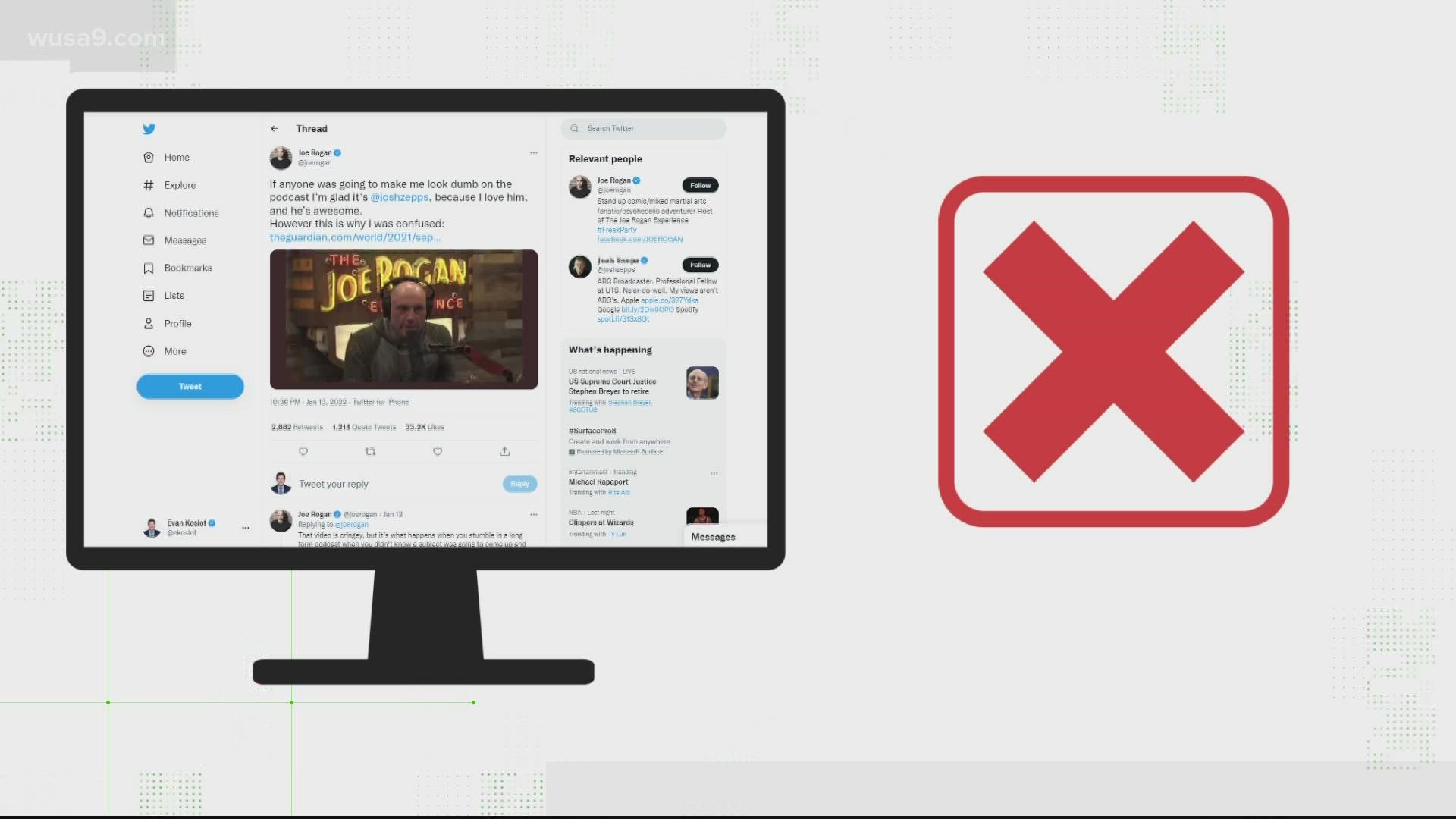WASHINGTON — In year three of the pandemic, it can still be difficult to know whether the information you see online or hear from friends is accurate. It could be misleading or misinterpreted—like playing a game of telephone with science.
One piece of information that gets a lot of talk is the risk of suffering from vaccine-induced myocarditis, which is inflammation of the muscles in your heart. It often presents with shortness of breath, chest pain, palpitations or fatigue.
Podcaster and comedian Joe Rogan talked about myocarditis on a recent episode of his widely streamed podcast, The Joe Rogan Experience, claiming that young men are more likely to suffer from myocarditis post-vaccine than post-COVID infection.
Rogan and his guest, Australian broadcaster Josh Szeps, disagreed and searched up a study that contradicted Rogan’s claims. Later, Rogan tweeted out a blog post calling that scientific finding into question.
These claims about myocarditis have circulated online for months, so we dug into the latest research to verify.
THE QUESTION
Are you more likely to suffer from myocarditis after getting vaccinated against COVID-19 than if you contracted COVID-19?
OUR SOURCES
- Dr. Amesh Adalja, Senior Scholar at Johns Hopkins Bloomberg School of Public Health
- Dr. Jean Jeudy, Professor of Radiology at the University of Maryland School of Medicine
- Dr. Steven Zeichner, Professor of pediatrics and infectious diseases at the University of Virginia School of Medicine
- Three studies published in December 2021 and a CDC study published in July 2021
THE ANSWER
No, our experts say myocarditis is not more common post-vaccine than it is post-COVID-19 infection. Vaccine-related myocarditis has been reported in 0.3-5 cases per 100,000 vaccinated people. But direct COVID-related heart injury or myocarditis is found in 1,000–1,400 per 100,000 people with COVID-19.
WHAT WE FOUND
As COVID-19 rapidly spreads, like it is in the United States now, our experts explain you are more likely to catch the virus and develop myocarditis as a complication than you would after being vaccinated. That’s because, as Dr. Adalja explains, these things do not exist in a vacuum.
“If there were no COVID-19, then the risk calculation is different,” Adalja said. “If there are high levels of COVID-19, the risk calculation is different as well, because it's all about trying to prevent severe disease from the virus.”
But, even when looking at simple comparisons, Dr. Jeudy says the risk levels are incomparable. Based on a December 2021 study he sent to Verify researchers, there are an estimated 1-10 cases of acute myocarditis per 100,000 people every year. The rate of vaccine-related myocarditis is between 0.3-5 cases per 100,000 vaccinated people. But the rate of direct COVID-associated cardiac injury or myocarditis is estimated to be 1,000-1,400 per 100,000 people with COVID-19.
When broken down by populations, two Israeli studies published in Dec. 2021 found that young men are at a higher risk of developing myocarditis after their second mRNA dose when compared to other age groups. One estimates that male patients from ages 16 to 29 had an incidence rate of 10.96 per 100,000 people, another estimates a rate of 13.73 per 100,000 people for the age group 16-19.
“To somehow suggest that the mRNA vaccines are worse than the risks from an unvaccinated person getting COVID is worse than wrong,” Zeichner said. “Myocarditis is also a rare complication in children given some other vaccines.”
So while we can verify that recent studies found that young men have a higher risk of myocarditis post-vaccination than other age groups, those rates are still low compared to the risk of developing myocarditis as a result of a SARS-CoV-2 infection.
But our experts also explain that the likelihood of developing myocarditis is not the only factor here: COVID-induced myocarditis can be more dangerous. A July 2021 CDC study found that the severity of these heart issues is worse for those who actually have COVID-19 vs those who were vaccinated.
“The overwhelming fraction of adolescent boys/young men with myocarditis after the mRNA vaccines have a mild disease with rapid recovery,” Dr. Zeichner says.
Dr. Jeudy explains that myocarditis following vaccination is a result of your body being introduced to a trace amount of SARS-CoV-2 and learning how to fight it. But when you’re sick with COVID-19, the virus is attacking you on all fronts.
“With direct COVID infection, the virus itself is attaching to different proteins on the myocyte–the heart muscle–and causing actual activation of inflammatory mediation. The body's trying to kill the virus, and with that there is damage to the myocardium,” Jeudy said. “Patients who do get COVID and get myocarditis as a result of it are more likely to be hospitalized, more likely to have more significant outcomes.”
The bottom line, according to our experts, is that contracting COVID-19 without being vaccinated can be dangerous. While cases skyrocket, a risk analysis of whether to get vaccinated needs to take uncontrolled spread into account. But for those who are more likely to suffer from myocarditis after a second mRNA dose, Dr. Adalja says there are other avenues you can take to be protected.
“It's a manageable risk, one that can be managed with different vaccine strategies,” he said. "You could get your first dose and then maybe wait eight weeks and get your second dose, and that myocarditis risk will be significantly less. Or, if you're above 18, you can get the Johnson & Johnson vaccine and not really worry about the myocarditis risk.”

